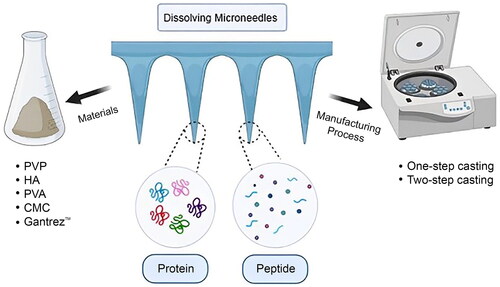Fabrication of dissolving microneedles for transdermal delivery of protein and peptide drugs: polymer materials and solvent casting micromoulding method

Proteins and peptides are rapidly developing pharmaceutical products and are expected to continue growing in the future. However, due to their nature, their delivery is often limited to injection, with drawbacks such as pain and needle waste. To overcome these limitations, microneedle technology is developed to deliver protein and peptide drugs through the skin. One type of microneedle, known as dissolving microneedles, has been extensively studied for delivering various proteins and peptides, including ovalbumin, insulin, bovine serum albumin, polymyxin B, vancomycin, and bevacizumab.
This article discusses polymer materials used for fabricating dissolving microneedles, which are poly(vinylpyrrolidone), hyaluronic acid, poly(vinyl alcohol), carboxymethylcellulose, GantrezTM, as well as other biopolymers like pullulan and ulvan. The paper is focused solely on solvent casting micromoulding method for fabricating dissolving microneedles containing proteins and peptides, which will be divided into one-step and two-step casting micromoulding. Additionally, future considerations in the market plan for dissolving microneedles are discussed in this article.
Read more on microneedles for transdermal delivery of proteins
Rr. Kirana Andranilla, Qonita Kurnia Anjani, Pietradewi Hartrianti, Ryan F. Donnelly & Delly Ramadon, Fabrication of dissolving microneedles for transdermal delivery of protein and peptide drugs: polymer materials and solvent casting micromoulding method, Received 19 Sep 2023, Accepted 14 Nov 2023, Published online: 21 Nov 2023, https://doi.org/10.1080/10837450.2023.2285498
Watch also our video and read more on Excipients for Parenterals here
Parenteral Excipients – See our introduction video:

